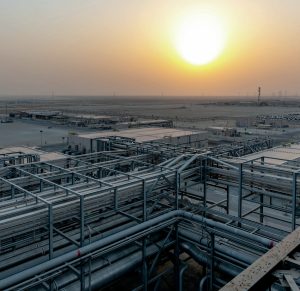
Middle East sulphur
The Middle East remains the world’s largest regional exporter of sulphur, with additional capacity continuing to come from both refineries and particularly sour gas processing.

The Middle East remains the world’s largest regional exporter of sulphur, with additional capacity continuing to come from both refineries and particularly sour gas processing.

Kazakh state gas company QazaqGaz says that work is progressing well and on schedule on the 1 billion m3 expansion project at the Kashagan Gas Processing Plant. A recent site report says that seven absorption columns have been installed at the sulphur treatment unit (each weighing between 50-170 tonnes); three sections of the smokestack have been installed at the sulphur recovery block, along with storage tanks and pumps for the heat carrier, instrumentation air, and nitrogen supply units; and a total of 2,177 t of process equipment has been installed. Welding works for tank assembly are ongoing, and over 12,000 meters of underground piping have been laid, and more than 38,000 cubic meters of concrete have been poured.
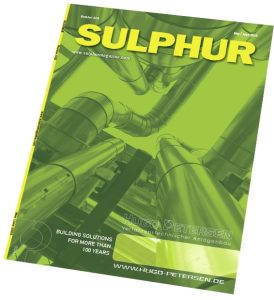
I am writing this freshly returned from the Sulphur Institute’s annual Sulphur World Symposium in Florence (for more on that see pages 24-25), where one of the topics causing some excitement was the anticipated commissioning of a demonstration plant for Travertine Technologies’ new Travertine Process. The plant is due to be commissioned at the Sabin Metals site near Rochester, New York in mid-2025 at a cost of $10.7 million. Capacity is put at “hundreds” of tonnes per year of gypsum processed, and removing “tens” of tonnes per year of CO 2 from the atmosphere.
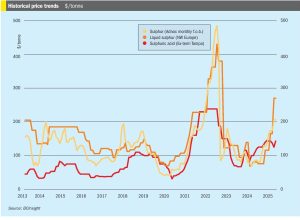
• Global sulphur prices are expected to stay relatively stable as purchases in Asia slow down due to the closing of the purchasing window for the Chinese spring fertilizer application season.

Axens says that it has completed the expansion of its Axens Catalyst Arabia Ltd site, aimed at providing local and regional partners with the latest tail gas treatment catalysts, in addition to the site’s legacy catalyst hydroprocessing manufacturing capacity. This makes Axens is the first and only company to produce tail gas treatment catalysts in the Middle East. The company says that the expansion consolidates its capacity to serve its regional customers to meet regulatory requirements and maximise sulphur recovery by up to 99.9%, minimising SOx emissions. The production site supplies the region’s refining and gas industries with the latest generation of Axens’ catalysts, capable of operating at lower temperatures than conventional catalysts, and resulting in lower energy consumption.
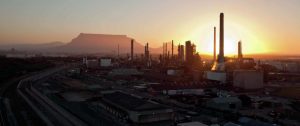
Astron Energy, a subsidiary of Glencore, says that it will spend $328 million to upgrade its South African crude oil refinery in order to comply with the country’s upcoming cleaner fuel regulations. The investment aims to bring the facility in line with South Africa’s Clean Fuels II standards, which mandate lower sulphur content in both petrol and diesel. The 100,000 bbl/d refinery near Cape Town is one of only two remaining operational refineries in the country. Astron says that construction work is already under way for a gasoline hydrotreating plant that will reduce sulphur levels to Euro 5 (<10ppm sulphur) specifications. The regulations have been delayed to July 2027 due to concerns over the cost of upgrading existing refining infrastructure. n
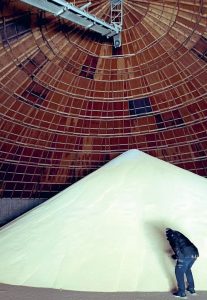
Mark Brouwer of UreaKnowHow.com reviews the main production options for incorporating sulphur into urea
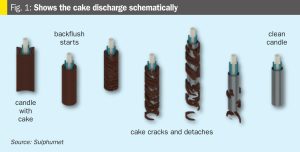
The Self-Cleaning Liquid Sulphur Candle Filter (LSCF) is setting a new benchmark in liquid sulphur filtration. With its innovative candle arrangement and advanced back-flushing technology, it enhances filtration rates significantly and minimises downtime for cake discharge. Jan Hermans of Sulphurnet explores the LSCF design, process parameters, and operational advantages.

Axens Catalyst Arabia Ltd to manufacture Tail Gas Treatment Catalyst on newly expanded site

Kuwait’s state owned Kuwait Oil Company (KOC) has issued a tender for companies to bid on construction of the second phase of its gas sweetening facility at booster station BS 171 in West Kuwait. Thirty-two companies have been pre-qualified to bid for the $390 million engineering procurement and construction (EPC) contract for the project. Phase II will involve the construction of two processing trains, each with a capacity to produce 60 million scf/d of sales gas from sour gas with an H2S content of 4%. Sulphur recovery from the project will come from two separate 100 t/d trains with a total capacity of 65,000 t/a of molten sulphur.